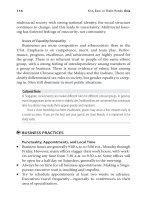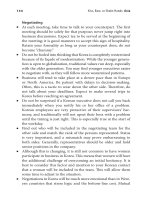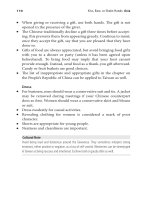Platform Scale (revised edition) How an emerging business model helps startups build large empires with minimum investment
Bạn đang xem bản rút gọn của tài liệu. Xem và tải ngay bản đầy đủ của tài liệu tại đây (2.13 MB, 325 trang )
"A compelling framework for building platforms, networks and marketplaces.
Essential reading for every entrepreneur and innovator."
— Jon Oringer, Founder and CEO, Shutterstock
How a new breed of startups
is building large empires
with minimum investment
Sangeet Paul Choudary
Platform Scale explains the design of a family of emerging digital business models
that enables today’s startups to achieve rapid scale: the platform business model.
The many manifestations of the platform business model - social media, the peer
economy, cryptocurrencies, APIs and developer ecosystems, the Internet of things,
crowdsourcing models, and many others - are becoming increasingly relevant.
Yet, most new platform ideas fail because the business design and growth strategies
involved in building platforms are not well understood.
Platform Scale is a builder’s manual for anyone building a platform business today.
It lays out a structured approach to designing and growing a platform business model
and addresses the key factors that lead to the success and failure of these businesses.
“The leading resource for understanding business models for the networked age.”
— Patrick Vlaskovits, New York Times Bestselling Author of The Lean Entrepreneur
“Many understand the power of platforms. Few understand how they work.
Only Sangeet tells you how to build them.”
— Nir Eyal, Wall Street Journal Bestselling author of Hooked
“Sangeet’s work brings science and structure to a host of emerging digital
business models.”
— Michael Karnjanaprakorn, Founder and CEO, SkillShare
“The go-to person when it comes to understanding digital economics.”
— ABC Mornings Radio Talk Show, at the G20 World Summit 2014
AUTHOR
Sangeet Paul Choudary is the founder of Platform Thinking Labs, a C-level advisor to
leading executives globally, a frequent keynote speaker, a fellow at the Centre for Global
Enterprise and an entrepreneur-in-residence at the INSEAD business school.
CONTRIBUTING AUTHORS
Geoffrey G Parker is a professor at Tulane University and a research scientist at MIT.
Marshall Van Alstyne is a professor at Boston University and a research scientist at MIT.
Sangeet, Geoffrey, and Marshall are also the co-authors of the book Platform
Revolution (details on page 321) and the co-chairs of the MIT Platform Strategy
Summit held annually at the MIT Media Labs.
Cover & Book design: Ideactio
“Today, we all understand the Internet business is not the software
business. We strive to build networks and platforms.”
— Evan Williams,
Founder of Twitter, Medium and Blogger,
“Medium is not a publishing tool”
PLATFORM SCALE
How an emerging business model helps startups
build large empires with minimum investment
Sangeet Paul Choudary
Copyright 2015 by Sangeet Paul Choudary
All rights reserved
First Edition
For information about permissions to reproduce selections
from the book, or about special discounts for bulk purchases,
please contact
ISBN No. 978-981-09-6757-4
Platform Thinking Labs Pte. Ltd.
For Devika
about the author
Sangeet Paul Choudary is a widely published researcher and advisor to C-level
executives globally, best known for his work on platform business models and
multi-sided network effects. He is the co-chair of the MIT Platform Strategy
Summit, held annually at the MIT Media Labs in Boston. Sangeet also acts as
an industry advisor to the Global Platform Data Project at Stanford University
and is an advisor at 500Startups in Silicon Valley. He is an Entrepreneur-in-Residence at INSEAD Business School and a Global Fellow at the Centre for Global
Enterprise in New York.
Sangeet is an advisor to C-level executives globally and has advised CXOs and
board members in multiple industries across Europe, North & South America,
Asia and Australia, on the design and implementation of platform business
models and network effects.
Sangeet is a regular keynote speaker at leading industry conferences globally
(represented by Celebrity Speakers Ltd.) and was invited to speak at the G20
World Summit 2014 events in Brisbane. He has lectured at leading universities
in the US, including Harvard Business School, Carnegie Mellon University and
the MIT Media Labs. He is a board member (advisory) of CoFounders Lab, the
world’s largest community of technology entrepreneurs.
At the G20 World Summit 2014 in Brisbane, he was hailed by the Australian
media as ‘a forefront researcher into how businesses can use metadata and
technology’ and ‘the go-to person when it comes to understanding digital
economics’.
Sangeet’s work has been featured and recommended on leading publications,
including the Wall Street Journal, Harvard Business Review, MarketWatch,
Forbes, WIRED Magazine and Fast Company. In the April 2015 issue of Thinkers
magazine on ‘Redefining Capitalism’, he was featured alongside globally leading
thinkers like Michael Porter and Don Tapscott. Sangeet is also a contributing
author to the book Managing Startups (O’Reilly Media, Inc) and the co-author
of the upcoming book Platform Revolution (W.W. Norton & Company, Inc).
For more details, please visit
/>
praise
“A compelling framework for building platforms, networks and marketplaces.
Essential reading for every entrepreneur and innovator.”
— JON ORINGER,
Founder and CEO, Shutterstock
“The leading resource for understanding business models for the networked age.
Highly recommended for entrepreneurs and innovation professionals looking to
build new platforms and networked businesses.”
— PATRICK VLASKOVITS,
New York Times Bestselling Author of The Lean Entrepreneur
“Many understand the power of platforms. Few understand how they work. Only
Sangeet tells you how to build them.”
— NIR EYAL,
Wall Street Journal Bestselling author of Hooked
“Sangeet’s work brings science and structure to a host of emerging digital business
models. A must read for every serious entrepreneur and innovator building
marketplaces or platforms.”
— MICHAEL KARNJANAPRAKORN,
Founder and CEO, SkillShare
“The go-to authority for the latest on platforms. Impeccably ties theory and business
practices with tangible example. His insight and foresight are tremendously
helpful.”
— REUVEN GORSHT,
Global Vice President, SAP
“The bible of digital media and emerging business models. I would strongly recommend Sangeet’s work on this topic to CIOs and Innovation leaders waiting to
unlock growth using digital.”
— UMANG BEDI,
Managing Director, South Asia, Adobe
“Unquestionably the paramount mind in platform thinking.”
— ANDREW GUNSBERG,
Television Host of Australian Idol, The Bachelor,
Live To Dance, The Hot Hits Live from LA
“The go-to person when it comes to understanding digital economics.”
— ABC MORNINGS RADIO TALK SHOW,
Australian Radio, at the G20 World Summit 2014
“An excellent source for managers to develop platform thinking and stay up-todate on the dynamics of platform-based markets.”
— PROF. FENG ZHU, PROFESSOR,
Harvard Business School
“A forefront researcher into how businesses can better use metadata and current
technology.”
— 4BC 1116 NEWS TALK,
Australian Radio, G20 World Summit 2014
“Sangeet is one of the deepest thinkers I know. He has helped countless startups
understand and unlock their core value as platform businesses. His work sits next
to Clayton Christensen and Geoffrey Moore.”
— MENG WONG,
Co-founder, JFDI
“One of the best innovation strategists in the world and an expert on building
platforms. His work is a must-read for entrepreneurs, investors, and innovators
worldwide.”
— KEVIN DEWALT,
Former EIR at NSF and Founder, SoHelpful.Me
“Sangeet’s work provides amazing insight into the success and failure of todays
business models, a resource that entrepreneurs and innovators cannot afford to
ignore.”
— FANG SOONG CHOU,
General Partner, PixVine Capital
“Sangeet’s platform analysis covers the topic with a depth that’s unique and
desperately needed. It’s forced me to rethink how I would structure digital business
models to leverage the gains from being a platform v product.”
— GEORGE BABU,
Founder of Rypple, acquired by Salesforce
“Sangeet’s insights reflect his wisdom across not only platform economics but
wider digital disruption issues.”
— CAT MATSON,
Panel Moderator, G20 Summit Global Cafe, Chief Digital Officer, City of
Brisbane
“Should be part of the curriculum of every business school throughout the world.”
— KJETIL OLSEN,
Vice President - International, UpWork
“I’ve assigned this as mandatory reading for my C-team.”
— GARY FORNI,
CEO, TuffWerx and former Global Director of Marketing, Intel
“A must-read for anyone in the ‘platform’ business.
— AVROM GILBERT,
COO of Seeking Alpha
table of contents
16
Preface
1
p. 19
1.1
p. 20
1.2
an introduction
to interaction-first
businesses
The Revolution Will Be
Platformed
The Platform
Manifesto
1.3
1.4
1.5
p. 46
The Rise Of The
Interaction-First
Business
p. 58
The Platform Stack
p. 33
p. 70
The Inner Workings
Of Platform Scale
p. 77
Conclusion
2
p. 79
designing the
interaction-first
platform
2.2
p. 80
Introduction
p. 90
Uber’s Drivers,
Google’s Crawlers
And GEs Machines
2.3
Building An
Interaction-First
Platform Business
2.1
p. 83
The New New Value
p. 97
2.4
Uber, Etsy,
And The Internet
Of Everybody
p. 104
2.5
p. 112
Personalization
Mechanics
2.8
p. 133
2.9
p. 156
3.3
Building User
Contribution Systems
Frictionless
Like Instagram
3.5
3.6
p. 181
The Traction-Friction
Matrix
Sampling Costs
3.8
3.9
p. 197
Uber Vs. Lyft
And Interaction Failure
p. 123
Pull-Facilitate-Match
p. 145
Introduction
p. 166
2.7
Emergence
p. 155
building
interaction-first
platforms
3.2
p. 117
The Core Interaction
The Platform Canvas
3
2.6
3.1
p. 159
Interaction Drivers
p. 172
3.4
p. 176
The Creation
Of Cumulative Value
p. 186
3.7
Trust Drives
Interaction
p. 201
Interaction Ownership
And The TaskRabbit
Problem
p. 191
4
p. 206
solving
chicken-and-egg
problems
4.2
p. 207
Introduction
p. 213
4.1
A Design Pattern For
Sparking Interactions
4.3
p. 219
4.4
Activating
The Standalone Mode
How Paypal And Reddit
Faked Their Way
To Traction
Every Producer
Organizes Their
Own Party
4.5
4.6
4.7
p. 226
p. 229
Bringing In The Ladies
The Curious Case
Of New Payment
Mechanisms
Drink Your
Own Kool Aid
4.8
4.9
4.10
p. 234
Beg, Borrow, Steal
And The World
Of Supply Proxies
4.11
p. 209
p. 238
Disrupting Craigslist
p. 223
p. 232
p. 242
Starting With
Micromarkets
p. 247
From Twitter To Tinder
5
p. 251
virality: scale in a
networked world
p. 252
Introduction
5.1
p. 254
Transitioning
To Platform Scale
5.2
p. 257
5.3
Instagram’s
Moonshot Moment
Going Viral
5.5
5.6
p. 265
A Design-First Approach
To Viral Growth
6
6.2
p. 274
p. 281
Introduction
p. 262
5.7
p. 277
The Viral Canvas
6.1
p. 283
A Scaling Framework
For Platforms
p. 290
Reverse Network Effects
p. 307
Epilogue
5.4
Architecting Diseases
Building Viral Engines
p. 280
reverse
network effects
p. 259
6.3
Manifestations
Of Reverse
Network Effects
p. 295
6.4
p. 301
Designing The
Anti-Viral, Anti-Social
Network
Platform Scale (n): Business scale powered by the ability to leverage
and orchestrate a global connected ecosystem of producers and
consumers toward efficient value creation and exchange.
PREFACE
Eating The World
In the late summer of 2011, Marc Andreessen, co-founder of Netscape and
the venture capital firm Andreessen-Horowitz, opined in a Wall Street
Journal op-ed that “software is eating the world.” Andreessen was referring
to firms like Amazon and Google that displace traditional industry leaders
with new business models. Ever since, the phrase has become a rallying
cry for every new startup hoping to build the next big thing.
Software has been around for several decades now, but its ability to “eat”
the world – to disrupt and reorganize traditional industries – has become
most apparent over the last decade and a half. During this period, software
has “eaten” media, telecom, professional services, and retail and is increasingly “eating” banking, healthcare, education, energy, transportation –
practically everything imaginable.
Yet it isn’t software itself that is eating the world. It is the ability of software
to orchestrate people and resources, make intelligent decisions, and enable
a connected global workforce to create value that is the real force driving
disruption today. Uber orchestrates the physical movement of cars and
16
travelers connected to the Internet, with its algorithms making intelligent
decisions. Facebook intelligently identifies the content that is most relevant
to a particular user, while Reddit organizes users around the world toward
an editorial function. Airbnb isn’t merely an app or a website; it is a central
market-making mechanism that allows the creation of an alternate market
for accommodations. Likewise, Amazon has done much to change power
structures in the publishing and retail industries. The Nest thermostat
demonstrates software’s ability to add a brain to physical objects. Nest’s
thermostats make intelligent decisions, constantly learning from their
surroundings and from the collective behavior of other connected thermostats.
Observed closely, the nature of software hasn’t changed. However, its ability
to organize labor and resources and make intelligent managerial decisions
has changed significantly over the last decade and more. The democratization of connectivity and the rise of data-driven decision-making systems
are leading to the emergence of a new range of business models. These
new software-enabled business models are “eating” the world.
We are no longer in the business of building software. We are increasingly
moving into the business of enabling efficient social and business interactions, mediated by software.
The systems mediating these interactions follow the platform business
model: a plug-and-play business model that allows connected users and
things to plug in and orchestrates them toward efficient interactions. Some
of us continue to believe, erroneously, that building superior technology
will determine business success in the future. Instead, as this book illustrates, leveraging technology – often commoditized – to orchestrate
connected users toward new and efficient value-creating interactions holds
the key to the business models of the future.
This book explains the inner workings of these new business models and
their ability to scale rapidly. The platform business model is powered by a
new set of factors that determine value creation and competitive advantage.
These factors are rapidly changing how entire industries operate. Upstarts
17
are disrupting deeply rooted traditional industries by leveraging platforms.
The decline of Nokia and Blackberry and the challenge of Uber and Lyft to
the taxi industry worldwide bear testament to this shift. Meanwhile, individuals and niche brands are gaining rapid market access by leveraging
platforms for global reach. Teenagers are building highly monetizable media
empires on YouTube, while many freelancers make a better living on Upwork
than they ever did or could at a traditional firm.
My fascination with platforms emerged from a desire to understand business success and failure in the context of emerging digital business models.
Platform Scale is an outcome of this growing fascination to unpack the
inner workings of business models in a networked world.
The ideas in this book aim to illustrate the importance of these models,
the forces that power their rapid scale, and the factors that will make them
the dominant business models in a networked world. While the effects
throughout society are self-evident, the causes are deeply contested and
only superficially understood. Platform Scale serves to create a lens to
analyze these changes and apply them to future platform-scale businesses.
This book is structured into six sections covering various aspects of platform scale. Section one introduces the concept of platform scale – the
mechanism by which these new business models scale rapidly – and explains
the shift in business thinking needed to manage businesses with platform
scale. Section two lays out a stepwise framework for the business design
of platform business models. Section three examines the core managerial
decisions involved in managing platform scale businesses. Section four
explores solutions to a problem specific to getting started with platform
scale: the chicken and egg problem. Section five lays out the science of
viral growth in a world of networks. Section six takes the counter view on
platform scale and identifies conditions where scale can work against
platform businesses. Finally, the epilogue proposes a framework for applying
these principles in large, traditional, incumbent business organizations.
As the world becomes more connected, the systems that best harness these
connected users and objects toward efficient social and business interactions will win. To successfully do so, these systems will need to understand
and leverage platform scale.
18
an introduction to interaction-first businesses
Section
1
AN INTRODUCTION
TO INTERACTION-FIRST
BUSINESSES
We are not in the business of building software,
We are in the business of enabling interactions.
19
platform scale
1.1
THE REVOLUTION
WILL BE PLATFORMED
An emerging family of business models has gained rapid traction over the
past decade. Businesses like Uber, Airbnb, and Twitter that were founded
less than a decade ago have rapidly grown to gain global adoption and built
multi-billion dollar business empires. Over the same period, companies
like Google, Facebook, Apple, and Amazon have demonstrated rapid valuation gains, becoming some of the highest-valued companies in the world.
These businesses seem to follow a different playbook to achieve scale. The
traditional principles of scaling a business no longer seem to apply, something that leaves incumbents confused. This introductory chapter explains
how the mechanics that drive business scale are changing and how the
new rules of scale create tremendous opportunities for businesses to
innovate and transform themselves.
pipes to platforms: a shift in business design
The Internet restructures the mechanics by which businesses create and
deliver value. This has important implications across industries and gives
20
an introduction to interaction-first businesses
rise to a whole new design for business. We are in the midst of transformative shift in business design as business models move from pipes to platforms.
Pipes have long served as the dominant business design for the industrial
economy. Firms build products or craft services, push them out, and sell
them to customers. Value is produced upstream and consumed downstream,
creating a linear flow of value, much like water flowing through a pipe. In
effect, pipes were designed to enable the flow of value in a straight line.
Pipes appear in nearly every area of modern industry. The traditional
manufacturing supply chain runs on a pipe model. Every consumer good
that finds its way into our hands comes down a pipe that constantly adds
value to the product. Our service organizations work like pipes; they
aggregate the resources for service provision and deliver those services
to clients. Traditional media – television, radio, and newspapers – are pipes
pushing content to us. Our education system often works like a pipe where
teachers push “knowledge” to receptive students. There is a linear movement of value from a producer to one or many consumers in all examples
of pipe businesses.
Early digital business models also followed the pipe design. The first media
companies on the Internet worked like pipes. Amazon’s e-commerce store
started as a pipe. Single-user software-as-a-service runs like a pipe, where
the software is created by the business and delivered to the consumer.
Even today, many businesses continue to see the Internet as a pipe, one
of many delivery channels.
However, three forces today – increasing connectedness, decentralized
production, and the rise of artificial intelligence – are driving a whole new
design for business. The emerging design of business is that of a platform.
Some of the fastest-scaling businesses of the last decade – Google, Facebook, Apple, Uber, and Airbnb – leverage the platform business model.
These businesses create a plug-and-play infrastructure that enables
producers and consumers of value to connect and interact with each other
in a manner that wasn’t possible in the past. Facebook provides an infrastructure for users to connect with each other and enables interactions
between them. Uber coordinates drivers and passengers toward economic
exchanges. Many businesses today act as platforms enabling interactions
21
platform scale
among their participants.
Platforms allow participants to co-create and exchange value with each
other. External developers can extend platform functionality using its APIs
and contribute back to the very infrastructure of the business. Platform
users who act as producers can create value on the platform for other
users to consume.
This changes the very design of the business model. While pipes created
and pushed value out to consumers, platforms allow external producers
and consumers to exchange value with each other. In this new design of
business where the firm is no longer the producer of value, platforms
perform two specific roles:
1. They provide an open, participative, plug-and-play infrastructure for
producers and consumers to plug into and interact with each other.
2. They curate participants on the platform and govern the social and
economic interactions that ensue.
Today, social platforms like Facebook, YouTube, and Twitter allow users
to create content and interact with each other. Marketplaces like eBay and
Etsy facilitate remote interactions. Some platforms, like Tinder and Airbnb,
facilitate in-person interactions. Others, like Uber and Munchery, manage
the coordination and movement of real-world resources in real time. All
these platforms perform the two key roles mentioned above. They provide
an open, plug-and-play infrastructure and govern the interactions that
ensue once participants come onboard the platform.
The enablement of interactions between external participants is a core
aspect of the platform business model. Enabling interactions on a plugand-play infrastructure requires a multi-directional flow of value between
different participants. This is different from pipes, which solely create and
push value out to consumers in a linear flow of value. The rise of platforms
demonstrates that we are in the midst of a fundamental change in the very
design of business.
As we note above, the mechanism of value creation on a platform is very
different from that in a pipe business. To understand this better and the
implications that this has on business scalability, it is helpful to understand
22
an introduction to interaction-first businesses
the three key shifts that are brought about by a shift from pipe to platform
business models.
pipes to platforms – three primary shifts
The movement from pipes to platforms is manifested through three key
shifts in the way that a business works.
a. Shift in Markets: From Consumers to Producers
In the traditional view of the market, the consumer was located at the end
of the pipe. The pipe would deliver products and services to the consumer.
The consumer’s relationship with the business was straightforward. The
business built what the consumer wanted, and the consumer paid for the
good or service, often with money but also with attention and engagement.
The functions of production and consumption were clearly demarcated.
On platforms, the business does not create the end value; rather, the business only enables value creation. As a result, participants on the platform
take on production as well as consumption roles. Sellers on eBay, drivers
on Uber, and video creators on YouTube act as producers and create value
on the platform. While pipes could focus solely on their consuming users,
platforms need to focus on producers as well as consumers. If the platform
cannot entice a group of producers to act and engage consistently, it is
unlikely to be successful at creating value.
b. Shift in Competitive Advantage: From Resources to Ecosystems
Pipes competed through resource ownership and control. This led to the
rise in popularity of the vertically integrated business as well as the idea
of scaling through mergers and acquisitions. In a world of pipes, firms
compete based on the control and ownership of internal resources and
intellectual property.
This traditional view of competitive advantage – that bigger is better and
the more you own, the more you win – has broken down. Domination
through the possession of vast monetary or physical resources – a hallmark
of the pipe world – does not apply to the world of platforms. Airbnb and
23
platform scale
Pipe
Figure 1
Pipe
Value
Producer
Producer
Consumer
Unit of Value moving
through the pipe
Consumer
Platform
Platform
Figure 2
PIPE AND PLATFORM ON THE SAME
PAGE
Producer
Consumer
Platform
24
an introduction to interaction-first businesses
Uber aren’t multi-billion dollar businesses because of the employees and
resources they control in-house but because of the ecosystem of producers
and consumers that they succeed in attracting, curating, and cultivating.
Platforms successfully orchestrate value-exchanging interactions in this
ecosystem using data about the various ecosystem participants. Ecosystems
are the key enablers of value creation on platforms and a new source of
competitive advantage. Platform giants will create massive value, not through
their access to physical resources but through leveraging data to orchestrate
physical and digital resources across their ecosystem.
c. Shift in Value Creation: From Processes to Interactions
Media companies have historically relied on the process of sourcing and
disseminating media. This has been partially replaced by interactions
between users on various social networks, such as Twitter and Facebook.
These platforms focus on matching the right content with the right
consumer based on certain parameters that the platform determines in
real time.
In linear pipes, value creation is centered on an end-to-end process that
shifts value down the pipe, from the producer to the consumer. On platforms, the interaction between producers and consumers, facilitated by
the platform, determines value creation and exchange.
Lack of resource ownership, as previously mentioned, works in tandem
with the movement from processes to ecosystem interactions. On Airbnb,
resources are owned by hosts; on Uber, resources are owned by drivers.
Platforms enable value creation and exchange by matching the most relevant resources from producers in the ecosystem with the consumers on
the platform that need those resources.
Value is no longer created and scaled merely through processes that organize
internal labor and resources. Instead, value is created and scaled through
interactions that orchestrate users and resources in the ecosystem. While
inventory-intensive companies like hotels have focused on maximizing
capacity utilization (process focus), emerging platforms like Airbnb and
Uber focus on improving the algorithmic matching of supply and demand
(interaction focus).
25









